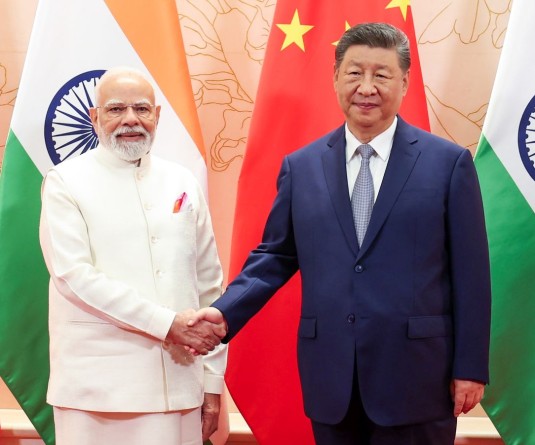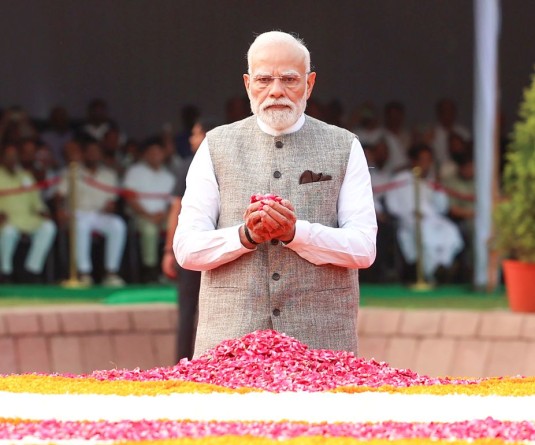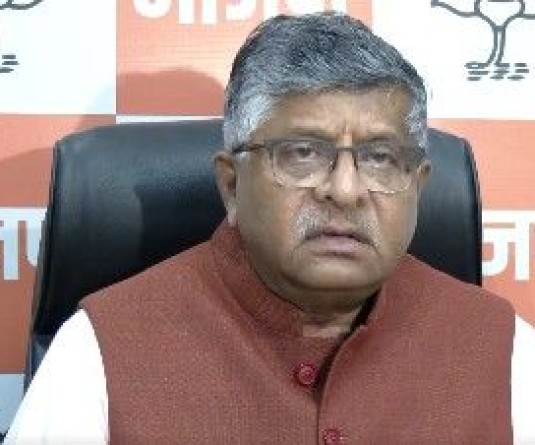Ambala: Farmers at Shambhu border (Punjab-Haryana) for their 'Delhi Chalo' march, near Ambala on Tuesday, Feb. 13, 2024. (Photo: IANS/Pawan Sharma)
.jpg)
New Delhi, February 13 (IANS) Almost two years after laying siege to the national capital, by farmers from Punjab, Haryana and Western Uttar Pradesh, Delhi borders turned into a fresh ‘battlezone’ on Tuesday with Farmers protest 2.0 ‘choking’ the city. Farmers, pertaining to the same region, 'launched ‘Chalo Delhi’ march, though with truncated strength and demands, starkly different from 2020-21 protests.
The main demand of protesting farmers, this time, is a legal guarantee of Minimum Support Price (MSP) for all the Kharif and Rabi crops, besides seeking Rs 10,000 pension for farmers above 60 years and more.
A MSP for Kharif and Rabi crops would mean that government lays down a fixed price, so that farmers get a ‘fixed’ income irrespective of the amount and quality of their crop produce.
Farmers have every right to seek ‘government shield’ but MSP for every crop is not feasible, tenable and justified, not just politically but also economically.
First talking about economic fallout, there exist a big gap between farmers demand and government’s MSP allocation, for years.
In the fiscal year 2020, the market value of agricultural produce stood at Rs 10 lakh crore and this included all 24 crops under MSP purview. However, the total MSP procurement in that year stood at Rs 2.5 lakh crore, which is just 25 per cent of the produce under MSP.
If the government cedes to farmers demand for legislation, thereby according it a guarantee, the exchequer would stand to bleed with additional expenditure of at least Rs 10 lakh crore annually.
Notably, this amount is almost equal to the Central government’s allocation of Rs 11.11 lakh crore, in the interim budget this year, for infrastructure development.
Moreover, this amount is more than the annual average expenditure on infrastructure in the last 7 fiscal years (2016-2023), which stands at Rs 67 lakh crore.
A careful assessment of the monetary figures makes for an easy judgement. The MSP guarantee law won’t be justified, reasonable and also economically tenable.
Politically, even if government bows down to farmers protest and agrees for MSP guarantee for all crops, it would need to earmark Rs 10 lakh crore every year. For raising such surplus money, government would have to either curtail expenditure on defence purchases and infrastructure development or burden the taxpayers with more levies and surcharges.
Experts believe that taking out Rs 10 lakh crore out of Rs 45 lakh crore Budget expenditure (for fiscal year 2025) for crops guarantee every year, makes for a poor and ill-devised judgement. It will not just burden the economy but also stifle government’s hands in taking farmer-friendly measures.
The farmers protest this time comes just months ahead of Parliamentary elections 2024. The 17th Lok Sabha has adjourned sine die and is in no way ‘empowered’ to frame a law/regulation on MSP for farm produce.
The ‘Delhi Chalo’ march in 2024 has the support of less than half of the 40 farmer organisations, that besieged the capital in 2020-2021. Many top leaders and faces of previous farm protests are ‘missing’ this time. Last time, the farm laws became the rallying point but this time, MSP for crops is the main agenda.
Even if government gives in to farmers demand as it did two years ago, a full Parliament session will be required to frame the MSP law.
At the outset, Farmers protest 2.0 looks more of a motivated, political demonstration and sponsored protest, allegedly with support of rival factions, rather than real fight for farmers’ rights and justice.
Haryana Police use tear gas to disperse protesting farmers at inter-state border
As hundreds of protesting farmers, mainly from Punjab, were stopped on Tuesday at the Punjab-Haryana Shambhu border to prevent them from reaching Delhi, Haryana Police fired tear gas to disperse them.
The farmers have been seeking a law on minimum support price (MSP) as one of their key demands.
Heavy security has been deployed and blockades erected at all borders in Haryana to prevent the marching protesters from moving ahead.
Even a drone has been deployed to drop tear gas shells on the protesters. Some of the empty shells, collected by protesters and shown to the media at the spot, expired in 2022.
Earlier in the day, thousands of farmers, led by over 200 unions under the banner of Samyukta Kisan Morcha (non-political) and the Kisan Mazdoor Morcha, embarked on the ‘Delhi Chalo’ protest march towards the national capital after several hours of a high-level meeting with farmer leaders and two Union ministers -- Agriculture Minister Arjun Munda and Food and Consumer Affairs Minister Piyush Goyal, in Chandigarh remained inconclusive.
At the meeting, the Union ministers were favouring a committee on the issue of the MSP but the farmer leaders turned that down.
The Centre also agreed to withdraw the cases against the farmers registered during the 2020-21 agitation. Also the Centre did not make any commitment on a loan waiver.
Samyukta Kisan Morcha (Non-Political) leader Jagjit Singh Dallewal, who participated in the meeting, told the media that several committees on the issue had already advocated the need to legalise the MSP. “So another committee would have served no purpose,” he said, adding “the government was also not serious on a loan waiver, though it waived off lakhs of crores of bad debt for big corporate”.
They accused the government of adopting a stubborn attitude. Sensing that the government did not agree on the MSP demand, they gave the go ahead to the march to Delhi on Tuesday, sources said.
A spokesperson for the Haryana Police said they have made elaborate arrangements to maintain law and order in the state.
“A total of 114 companies have been deployed in various districts of the state, out of which 64 companies are from paramilitary forces and 50 companies are from Haryana Police,” spokesperson and Assistant Inspector General Manisha Chaudhary said.
Farmers have planned to enter Haryana from Shambhu border in Patiala, Moonak in Sangrur, Dabwali in Muktsar and Ratia in Mansa. The Haryana Police have sealed all four entry points by putting up barricades, boulders, tippers filled with sand and barbed wires and iron spikes, impacting the movement of vehicular traffic with huge traffic snarls.
Security has also been beefed up along the Singhu, Ghazipur and Tikri borders to stop protests in Delhi.






